Around the late 1980s, Larry Robin was searching for an artist to depict the man he and his collaborators wanted to honor with a festival: Paul Robeson.
Robeson had long dissolved into history through no fault of his own. But Robin had been mesmerized by this man of many talents from way back when. Later, he would get to know other ardent admirers such as historian Charles L. Blockson, who told him about meeting Robeson a few years before he died in 1976.
Sheila Whitelaw, then executive director of the Friends of the Free Library, had just the person. Her husband-to-be, Roland Ayers, was a noted artist who created detailed stories in intricate pen-and-ink drawings. Ayers was slightly familiar with Robeson, she says, but didn’t know much about him. She bought Ayers a book and the artist did some research on his own about this singer, actor, activist, scholar, star athlete and lawyer.
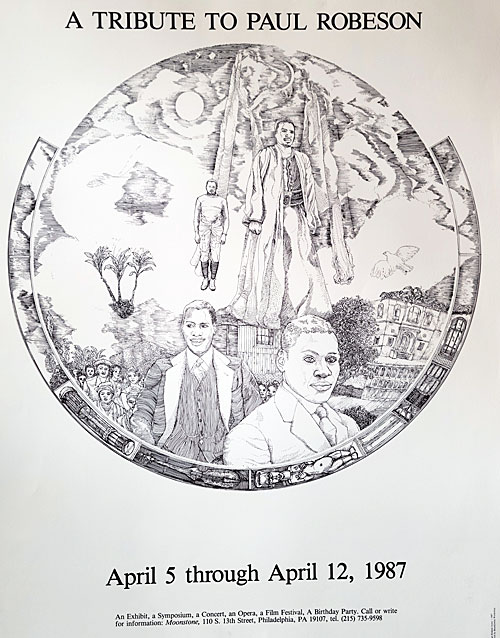
Ayers created the drawing in 1987 for the first Paul Robeson Festival, which was designed to re-acquaint people with Robeson and the principles he espoused.
Recently, Robin donated a print of Ayers’ drawing to the West Philadelphia Cultural Alliance/Paul Robeson House & Museum (WPCA). It will hang in the house at 4951 Walnut Street in Philadelphia where Robeson lived the last 10 years of his life with his sister Marian Forsythe. Frances P. Aulston and the WPCA bought the house in 1984 to carry on Robeson’s legacy of using art as a means of social action and change.
The Robeson drawing – titled “Paul Robeson” – is one of several festival posters and prints donated by Robin. Among them is an Ayers’ pen-and-ink drawing titled “Originating.” Like the Robeson print, there are 100 in the edition. The posters are from the festival, which ran from 1987 to 1994.
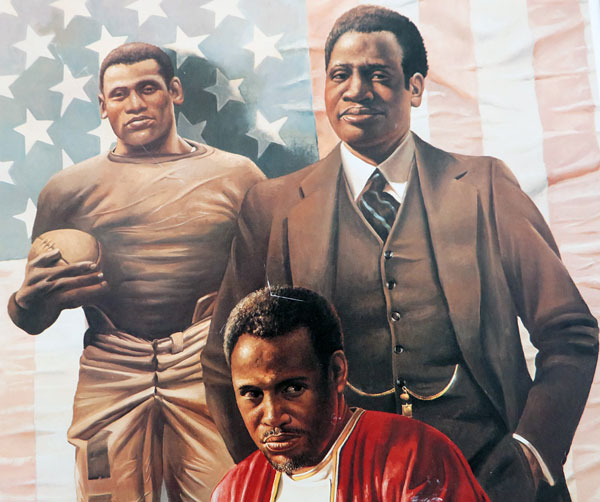
“I am just incredibly happy that more people will see this stuff because I think it’s important,” says Robin, 79, owner of Moonstone Arts Center whose Robin’s Bookstore for years was a nexus for Black books and Black writers. “Nobody owns nothing. It’s all to be shared.”
A print from the “Paul Robeson” edition is part of an exhibit of Ayers’ works at the Woodmere Art Museum in Philadelphia. The exhibit “Roland Ayers: Calligraphy of Dreams” runs until Oct. 24, 2021. The Robeson House and Woodmere have collaborated on a members exchange with events scheduled at both locations. (See registration info below.)
Robin has a longtime connection to the house. In 2009, he was among several people interviewed for the book “Stories from the Paul Robeson House: Lives Touched by a Renaissance Man.” It was an anthology of recollections and essays produced by the WPCA in conjunction with WHYY. In 2013, he received a Paul Robeson Freedom Fighter Award from Aulston. and the WPCA. Each year, the organization honored several people who had worked to recognize the contributions and importance of Robeson.
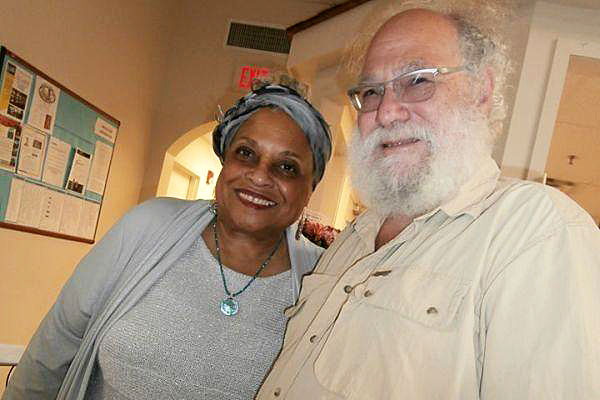
“We are appreciative to Larry Robin, a longtime supporter of WPCA/Paul Robeson House & Museum, for his generous donations,” says Janice Sykes-Ross, executive director of WPCA. “These types of artifacts help to bring the story of Robeson’s legacy to life.”
When Robeson died in 1976, few in the city knew that he had lived in a twin house in West Philadelphia. Even fewer remembered the giant who had been both admired and denounced for his beliefs and activism. He started out in the 1920s as an actor playing the roles he was given with very little consciousness. Then he began to question the way those roles – and himself as an actor – portrayed Black people. He first sang “Ol’ Man River” in the movie “Show Boat” in 1936 as it was stereotypically written. After adding it to his repertoire, he changed the lyrics into a song of defiance.
Robeson called out the United States government for its treatment of Blacks in this country and bonded with oppressed people all over the world, regardless of their color. He protested in speeches and songs, rallying people with his calls for freedom and against servitude.
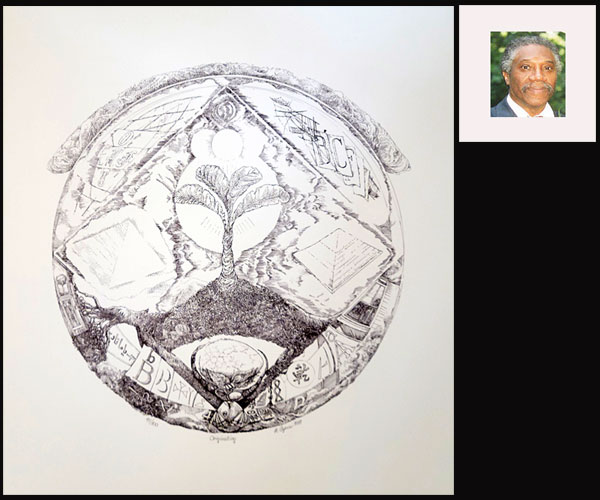
For his activism, he was condemned: His record sales dried up; venues closed to him; the FBI put him and his wife Eslanda under surveillance; the State Department rescinded their passports so he could not travel abroad to sing, effectively cutting off much of his income; a mob of whites attacked his supporters at a rally in Peekskill, NY, and the House Un-American Activities Committee tried to force him and Eslanda to acknowledge or deny that they were Communists. They refused.
Despite the travel restriction, Robeson sang in the first transatlantic concert from New York to an audience in London via underwater telephone cables. On the West Coast, he sang across the border in Washington state to supporters in Canada.
“The artist must make a choice to fight for freedom or oppression,” says Robin, referring to one of Robeson’s famous statements. “He was always on the front line and trying to change the culture.”
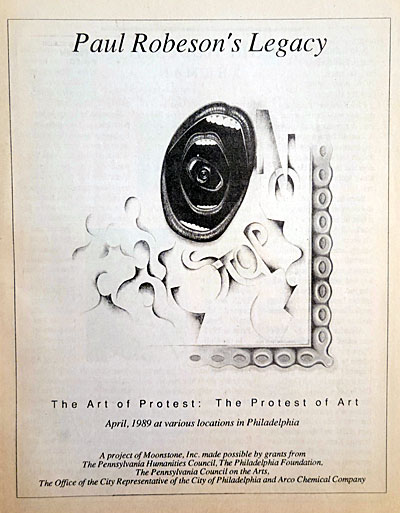
Arts and politics are interconnected, Robin told an interviewer in 1993, and that was the purpose behind the Robeson Festival. But even before the festival, Robin had spotlighted Black culture through Moonstone’s “Celebration of Black Writing,” which he says was organized by him and Blockson. Starting in 1981, the annual event brought together celebrated authors to discuss the state of Black writing. It lasted for 18 years before it was handed over to Art Sanctuary.
Robin’s Bookstore itself had long been a place where people would come to present and listen to poetry and prose, almost exclusively find books by Black writers, view exhibits, participate in a reading series and listen to music. There once was a preschool with art at its core. Until the bookstore closed in 2012, Robin says, there were 200 to 300 programs a year.

The bookstore was a family tradition; his grandfather opened it in 1936, and his father inherited it. When Robin finished high school, he joined them, eventually sharing the place with his father and uncle. He says by age 16, he was an activist and he read constantly. He alternated between left-wing politics and science fiction. He was always radical in his choice of books for the store, lining its shelves with writings by leftist thinkers.
“My parents left things wide open for me, but they didn’t proselytize at all,” says Robin. His uncle was more conservative, he says, and questioned some of his choices. “He didn’t understand why I was bringing in (Beat poet) Allen Ginsberg, but if (his works) sold, it was okay with him. My father had a more radical viewpoint, although he didn’t express it verbally.”
The Robeson Festival was the brainchild of Robin’s Moonstone, Blockson of the Charles L. Blockson Afro-American Collection at Temple University and Joyce Brown of Swords into Ploughshares, a music production company. The first one garnered huge publicity: The Inquirer published a big story, the city of Philadelphia proclaimed the week of April 2-11 as “Paul Robeson Week” and the PECO utility company put it in lights at the top of its building.
“It was amazing,” says Robin. “He had been repressed and ignored for so long. It was time.”
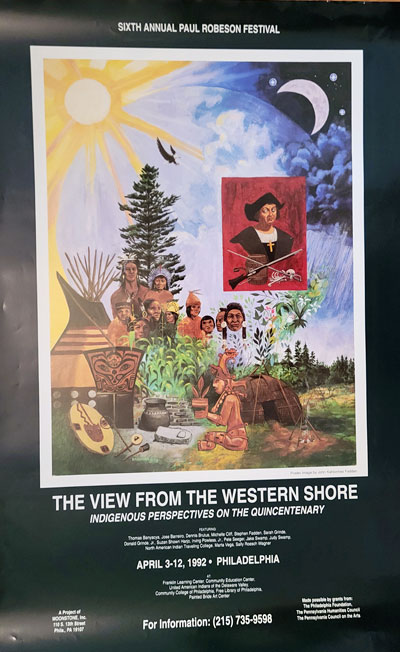
Ayers’ drawing was used on the first poster in 1987, titled “A Tribute to Paul Robeson.” The artwork was printed at the Brandywine Workshop, which since 1975 has offered residencies for artists to produce limited edition and original prints.
Ayers grew up in the Germantown section of Philadelphia. He started drawing in first grade, filling his schoolbooks with all types of airplanes, says Sheila, who married Ayers in 1992. He attended the Philadelphia College of Art (now the University of the Arts), where he created pen-and-ink drawings, watercolors, gouaches and collages. Ayers spent some time painting in Greece and Holland in the 1970s, living in locations where he felt his art was more appreciated, says Sheila.
For years, he managed the Friends of the Free Library bookstore until he developed Alzheimer’s. He died in 2014.
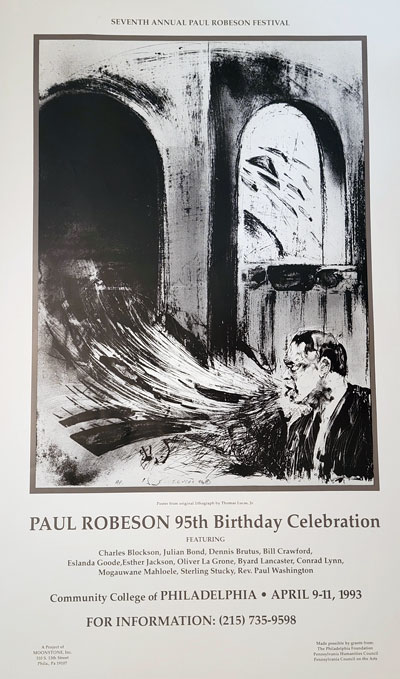
“I see myself as a radical,” Ayers said in a magazine article in 1976. “Some people tend to see the differences rather than the similarities between themselves and other people, or between themselves and the environment. Western culture has chosen to be an opponent of nature rather than a part of it.”
Sheila, who was born in England, says she encouraged him to create the drawing of Robeson, whom she met as a child in London in the late 1940s.
Her father took her to a rally for union workers, she says, and she listened as Robeson told a diverse crowd of the importance of being unionized. “They were mesmerized by Robeson because he had this commanding speaking voice and he was a very very big man,” Sheila recalls. With her father, she went backstage after the speech. “I remember shaking his hand. I’m looking up to him and thinking to this day I think I met God. It sounds corny but that’s what I thought,” she says.
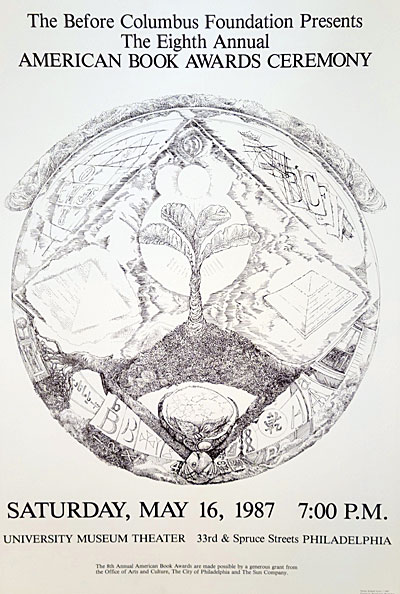
Robin commissioned the drawing, he says, paying Ayers a small financial token of appreciation. Sheila says he was proud to do it.
Initially, he wasn’t satisfied with his finished product, Sheila recalls, telling her “it really doesn’t look like Robeson.’ And I said, ‘it does. You really captured the whole feeling of who he was.’ We put it up on the wall so he could look at it a lot, and it started to grow on him. I remember him saying, ‘you’re right. I like this piece.'”
Each year, the festival bore a different theme that fitted into Robeson’s beliefs and the things he stood for. After seven years, the grant money that had fed the festival dried up. “People deserve to be remembered (and) praised for what they’ve done,” says Robin.
____________________________________
Members Exchange between the Paul Robeson House & Museum and Woodmere Art Museum:
Saturday, Oct. 9, 2021, at Woodmere
“Remembering Paul Robeson: Up Close and Personal,” a conversation between Vernoca L. Michael, former executive director of the WPCA/Paul Robeson House & Museum, and Hildy Tow, the Robert L. McNeil, Jr. Curator of Education at Woodmere. The conversation is inspired by a lithograph of Robeson by artist Roland Ayers, on view in Woodmere’s exhibition “Roland Ayers: The Calligraphy of Dreams.”
To register (seating is limited):
https://www.tix.com/ticket-sales/woodmereartmuseum/6096/event/1235798
Note: The registration process for Woodmere requires that you have a logon or create an account. If you already have an account, you will be asked for a password. If you have a problem creating an account, please call Joe Pompilii at Woodmere at 215-247-0476 or email jpompilii@woodmereartmuseum.org.
Special jazz concert: Robeson House supporters are encouraged to stay for Woodmere’s jazz concert at the Museum’s members’ rate of $15/ticket (tickets are limited). The concert features vocalist Jackie Greggs who joins The Arpeggio Jazz Ensemble in a tribute to Al Green.
COVID protocols at Woodmere: The museum requires either proof of vaccination or a negative COVID test in the preceding 72 hours. While visitors can present this at the time they arrive, the museum is encouraging those who are able to use Bindle, a free app that allows users to upload their information securely, and then simply scan a barcode when they arrive to expedite the check-in process. You can find more info at https://joinbindle.com/
To purchase tickets for the “Tribute to Al Green” at 5pm or 7pm that night:
https://www.tix.com/ticket-sales/woodmereartmuseum/6096/event/1234300
The registration process is the same as above. Discount code: Robeson.
2 pm Sunday, Oct. 17, 2021
“A New Twist on Art Collecting” & Paul Robeson House & Museum Tour
As part of the Parlor Talks series, Robeson House volunteer Sherry L. Howard will offer a presentation and book signing for her new book “ART WITH HEART: How I Built a Sweet Collection by Buying Cheap at Auction.” Sherry has been collecting art at auctions for years. Roland Ayers is among the artists featured in the book, available at amazon.com.
To register (seating is limited):
https://bit.ly/artcollectingrobeson
COVID protocols at Robeson House: Masks are required.